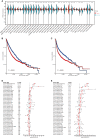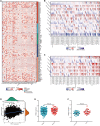PSMC2 is a Novel Prognostic Biomarker and Predicts Immunotherapeutic Responses: From Pancreatic Cancer to Pan-Cancer
- PMID: 37581119
- PMCID: PMC10423611
- DOI: 10.2147/PGPM.S418533
PSMC2 is a Novel Prognostic Biomarker and Predicts Immunotherapeutic Responses: From Pancreatic Cancer to Pan-Cancer
Abstract
Background: Proteasome 26S subunit ATPase 2 (PSMC2) is a part of the 19S regulatory complex, which catalyzes the unfolding and transport of substrates into the 20S proteasome. Our previous research demonstrated that PSMC2 participates in the tumorigenesis and progression of pancreatic cancer (PC). However, no systematic analysis has been conducted to conclude its expression pattern and correlation with tumor immunity.
Aim: To investigate the expression level of PSMC2 in PC, its prognostic value and its relationship with tumor immunity.
Methods: In numerous public and internal cohorts, the expression, prognostic significance, and immunological connections of PSMC2 in PC were investigated. Additionally, using data from The Cancer Genome Atlas (TCGA), a pan-cancer analysis was carried out to examine PSMC2's immunological assocaition, and the predictive power of PSMC2 for immunotherapy was also evaluated in numerous public cohorts.
Results: PSMC2 was overexpressed in tumor tissues and linked to unfavorable prognosis in PC. PSMC2 was not only positively correlated with TIICs, also positively correlated with immune checkpoints in PC. In addition to PC, PSMC2 was expected to be an indicator of high immunogenicity in most cancer types. Importantly, PSMC2 could predict the immunotherapeutic responses in various cancer types, including urothelial carcinoma and breast cancer.
Conclusion: From PC to pan-cancer analysis, we report that PSMC2 is a novel prognostic biomarker in multiple cancer types. PSMC2 is related to the immuno-hot phenotype and predicts the outcome of immunotherapy. Therefore, the current study emphasizes that cancer patients with high PMSC2 expression should actively receive immunotherapy to improve their prognosis.
Keywords: PSMC2; bioinformatics; biomarker; pancreatic cancer; tumor immunity.
© 2023 Huang et al.
Conflict of interest statement
The authors declare that they have no competing interests in this work.
Figures





Similar articles
-
GBP2 is a prognostic biomarker and associated with immunotherapeutic responses in gastric cancer.BMC Cancer. 2023 Oct 2;23(1):925. doi: 10.1186/s12885-023-11308-0. BMC Cancer. 2023. PMID: 37784054 Free PMC article.
-
Comprehensive pan-cancer analysis of role of GPRASP1, associated with clinical outcomes, immune microenvironment, and immunotherapeutic efficiency in pancreatic cancer.Pathol Res Pract. 2023 Mar;243:154374. doi: 10.1016/j.prp.2023.154374. Epub 2023 Feb 12. Pathol Res Pract. 2023. PMID: 36801507
-
Silencing of Proteasome 26S Subunit ATPase 2 Regulates Colorectal Cancer Cell Proliferation, Apoptosis, and Migration.Chemotherapy. 2019;64(3):146-154. doi: 10.1159/000502224. Epub 2019 Nov 12. Chemotherapy. 2019. PMID: 31715603
-
Knockdown of PSMC2 contributes to suppression of cholangiocarcinoma development by regulating CDK1.Aging (Albany NY). 2021 Sep 9;13(17):21325-21344. doi: 10.18632/aging.203463. Epub 2021 Sep 9. Aging (Albany NY). 2021. PMID: 34499615 Free PMC article.
-
PSMC2 is Up-regulated in Pancreatic Cancer and Promotes Cancer Cell Proliferation and Inhibits Apoptosis.J Cancer. 2019 Aug 27;10(20):4939-4946. doi: 10.7150/jca.27616. eCollection 2019. J Cancer. 2019. PMID: 31598166 Free PMC article.
References
-
- Wang X, Li X, Wei X, et al. PD-L1 is a direct target of cancer-FOXP3 in pancreatic ductal adenocarcinoma (PDAC), and combined immunotherapy with antibodies against PD-L1 and CCL5 is effective in the treatment of PDAC. Signal Transduct Target Ther. 2020;5(1):38. doi:10.1038/s41392-020-0144-8 - DOI - PMC - PubMed
LinkOut - more resources
Full Text Sources

